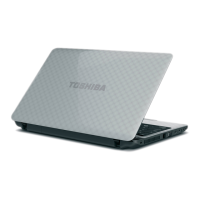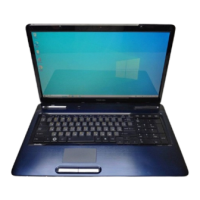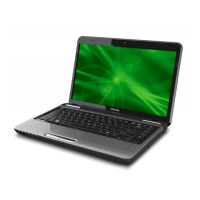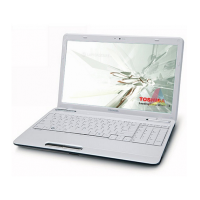
Do you have a question about the Toshiba Satellite L750D and is the answer not in the manual?
| Operating System | Windows 7 Home Premium |
|---|---|
| Battery | 6-cell Li-ion |
| Optical Drive | DVD SuperMulti Drive |
| Processor | AMD A6-3400M |
| RAM | 4GB DDR3 |
| Storage | 500GB HDD |
| Display | 15.6-inch HD (1366 x 768) |
| Graphics | AMD Radeon HD 6520G |
| Weight | 2.5 kg |
| Ports | 2 x USB 2.0, 1 x USB 3.0, HDMI, VGA, Ethernet |
| Wireless | Wi-Fi 802.11 b/g/n |
Explains formatting, terms, and abbreviations used in the manual.
Details the physical layout of the computer's exterior, including ports, indicators, and components visible from all sides.
Describes the computer's core hardware components, including processor, memory, storage, and power adapter.
Details pre-installed software utilities, applications, and special features for system management and convenience.
Covers optional devices, memory card slots, media care, and connectivity ports like HDMI and security locks.
Guides on basic operations like touchpad, webcam, face recognition, power connection, and initial startup.
Explains how to use optical drives, write discs, and utilize disc creation software.
Explains keyboard layout, key types, hot keys, and special character generation for efficient typing.
Explains power conditions, indicator lights, and battery status monitoring for optimal power use.
Covers battery usage, replacement, charging, password security, and power-up modes for system management.
Details how to configure hardware settings, including passwords, display, boot order, and connectivity options.
Provides systematic steps and checklists for identifying and resolving computer issues effectively.
Addresses troubleshooting for various computer components and peripherals, including power, drives, memory, and connectivity.
Guides on initial setup, connecting power, opening the display, and first-time startup procedures.
Covers power management modes, system recovery, creating recovery media, and restoring software.
Details the physical layout of the computer's exterior, including ports, indicators, and components visible from all sides.
Describes the memory media slot, security lock, and cooling vents for device management.
Details LAN, external monitor, and USB ports for computer connectivity.
Describes HDMI, microphone, headphone, and USB ports for multimedia and audio connections.
Details the modem jack, optical drive, and DC IN port for power and connectivity.
Illustrates underside components like battery locks and the memory module slot for maintenance.
Describes components visible when the display is open, including camera, screen, and control buttons.
Details keyboard layout, touch pad controls, speakers, and display hinges for user interaction.
Explains the meaning of various system indicator LEDs on the computer for status monitoring.
Explains indicators for power, battery, drive activity, wireless status, and keyboard locks.
Lists optical drive types and details about writable CD, DVD, and Blu-ray discs.
Details the AC adapter's voltage adjustment and connection for powering and charging the computer.
Describes the computer's processor, memory configuration, and battery pack.
Explains storage drives, RTC battery function, and AC adapter specifications.
Covers optical drive types and display power saving technology for optimized performance.
Details graphics controller, sound system, and AMD Vari-Bright power saving feature.
Describes multimedia devices and communication interfaces like modem, LAN, Bluetooth, and Wireless LAN.
Highlights unique features like hot keys, power management, and security options for enhanced usability.
Details power management features including intelligent supply, battery save, panel control, and hibernation.
Explains Sleep Mode, USB charging, USB wakeup, and the PC Health Monitor for system status.
Lists system utilities for power saving, diagnostics, hardware setup, and accessibility support.
Describes key software applications like face recognition, video player, Bluetooth, and system assistance tools.
Details software for disc creation, DVD-RAM utility, Blu-ray playback, drive alerts, and service station.
Describes Corel Digital Studio for multimedia creation and Corel Label@Once for disc labeling.
Covers eco utility, media player enhancement, organization tools, and file history viewers.
Details media control, speech system, and optional devices like memory cards and peripherals.
Provides detailed information on the memory media slot and supported card types, including precautions.
Covers safety precautions for memory media and formatting procedures for SD cards.
Provides care instructions for media and memory cards, and how to insert them correctly.
Provides instructions on how to safely remove memory media from the slot, with precautions.
Explains how to install additional memory modules to increase system memory, with safety guidelines.
Step-by-step guide for installing a memory module, including precautions against static electricity.
Step-by-step guide for removing a memory module, including safety precautions.
Guides on connecting an external analog monitor to the computer for extended display.
Details connecting monitor cables via VGA and HDMI ports for display output.
Guides on plugging the HDMI cable into the computer and the HDMI device for video and audio output.
Explains how to configure settings for HDMI video display and utilize the HDMI 1.4 3D Video feature.
Covers physical security using a lock and lists optional accessories for enhancing computer functionality.
Explains how to use the Touch Pad for cursor control and basic operations.
Describes the Web Camera's functionality, pixel count, and setup for video and photography.
Details how to use face recognition for login and includes disclaimers about its security and accuracy.
Guides on registering face data for facial verification and login, including practice steps.
Covers deleting face data and logging into Windows using face recognition via different modes.
Explains how to use optical disc drives and provides steps for loading discs.
Provides steps for safely removing discs from the drive, including manual release if needed.
Details which drives support writing to CD/DVD/Blu-ray discs and the software used.
Provides crucial instructions and disclaimers before writing or rewriting media to avoid errors and data loss.
Lists important points to observe while writing or rewriting data to discs, including media quality and system stability.
Explains limitations and features of the TOSHIBA Disc Creator software for disc creation.
Covers disc data verification and creating Labelflash DVDs and video movies using Corel software.
Lists limitations and important notes for writing Video DVD or Blu-ray Disc™ movies, including software requirements.
Provides important notes on using the TOSHIBA VIDEO PLAYER software and its limitations, including playback compatibility.
Explains settings for display devices and audio output for optimal video playback.
Details the 3D playback feature for Blu-ray discs and its requirements, including display compatibility.
Guides on starting, operating, and accessing help for the VIDEO PLAYER.
Provides important limitations and notes for using WinDVD BD for TOSHIBA, focusing on Blu-ray playback.
Details how to configure 3D playback for Blu-ray discs on compatible displays and TVs.
Provides notes on playing Blu-ray 3D content, including potential issues and requirements.
Covers media care for discs and adjusting system volume and sounds for audio output.
Explains audio configuration tools and Dolby Advanced Audio features for enhanced listening experiences.
Guides on adjusting microphone levels and notes on microphone usage, including feedback prevention.
Explains modem region selection and connecting the modular cable for telecommunication access.
Explains disconnecting the modem cable and provides an overview of wireless communication functions.
Details Wireless LAN compatibility and explains the wireless communication indicator status.
Details Wireless LAN setup, security measures, and the functionality of Bluetooth technology.
Covers wireless links, Bluetooth security, software notes, product support, and enabling/disabling wireless communication.
Explains wireless indicators, LAN support, and required LAN cable types for optimal connection.
Guides on connecting and disconnecting the LAN cable to the computer and network for internet access.
Provides instructions for cleaning the computer and safe procedures for moving it to prevent damage.
Explains the Sleep Utility and the Sleep and Charge function for powering USB devices when the computer is off.
Details USB charging modes, battery settings, and heat dispersal mechanisms for system protection.
Explains the function of standard typewriter keys for text input.
Explains function keys, soft keys, and keyboard emulation on a smaller layout for enhanced usability.
Lists and explains hot keys for quick access to system features like volume, sleep, and display control.
Details hot keys for wireless, touchpad, zoom, volume, and icon size adjustments.
Allows making the FN key sticky via TOSHIBA Accessibility utility for easier hotkey access.
Describes Windows special keys and generating ASCII characters using keyboard shortcuts.
Details computer states when power is on or off, depending on AC adapter and battery status.
Explains system indicators and how to interpret battery status lights for power management.
Details power indicators, battery types, and the primary battery pack for system operation.
Explains the RTC battery's function and provides safety precautions for battery pack care and handling.
Guides on charging the battery pack and refers to user information for charging time details.
Explains potential battery charging issues and methods to monitor battery capacity and operating time.
Offers advice on maximizing battery operating time and extending its lifespan through proper usage and maintenance.
Guides on removing the battery pack, including step-by-step instructions and safety precautions.
Provides step-by-step instructions for installing the battery pack securely, with safety guidelines.
Explains how to set and manage user and supervisor passwords for system security and access control.
Guides on how to start the computer using the user password for secure login.
Describes power modes, Windows utilities, hot keys, and automatic power-off features for system management.
Explains how to access and navigate the HW Setup program for computer configuration.
Details BIOS version display and managing user/owner string passwords in HW Setup for system security.
Covers display customization and configuring boot device priority for startup sequence.
Details boot speed, panel power control, keyboard wake-up, and LAN wake-up settings for system functionality.
Explains settings for built-in LAN, USB legacy support, and SATA interface configuration for connectivity and storage.
Provides systematic steps and checklists for identifying and resolving computer issues effectively.
Covers troubleshooting for system startup failures, self-tests, and power-related problems including AC adapter and battery.
Addresses issues related to overheating, AC power, and battery problems, guiding users to check indicators and connections.
Guides on troubleshooting AC power issues and battery charging problems by checking indicators and connections.
Addresses battery issues like not powering the computer or not charging as expected, suggesting solutions like full discharge.
Troubleshoots issues with the real-time clock, keyboard output, and internal display panel problems.
Troubleshoots display panel issues and hard disk drive problems including boot failures and slow performance.
Helps troubleshoot problems with DVD and Blu-ray drives, including disc access and writing issues.
Troubleshoots memory card errors and issues with pointing devices like touchpads and mice, covering sensitivity and responsiveness.
Troubleshoots issues with USB mice and other USB devices, including connection and functionality problems.
Addresses problems with additional memory modules and the sound system, including no sound or annoying sounds.
Troubleshoots problems with external monitors not turning on or displaying correctly, including clone mode issues.
Addresses issues with modem initialization, connection, and communication errors, including dial tone and connection failures.
Helps resolve problems with LAN, Wireless LAN, and Bluetooth connectivity, including access and wake-up issues.
Explains recovery media creation issues and provides information on contacting Toshiba support for assistance.
Lists Toshiba contact addresses for hardware-related problems outside and inside Europe.
Details the computer's physical size and environmental operating requirements for optimal use.
Lists power requirements and technical specifications for the built-in modem, including communication protocols.
Explains the display controller and how to configure video mode settings for optimal screen output.
Describes Wireless LAN and Bluetooth compatibility with various systems and products, including standards compliance.
Provides cautions regarding wireless device use, potential interference, and health safety related to radio frequency energy.
Outlines radio frequency and safety standards compliance for wireless devices in Europe, including usage restrictions.
Details wireless device regulations in Canada, USA, Taiwan, and RF exposure/interference cautions.
Provides important notices and indications for using wireless equipment in Japan, including frequency bandwidth information.
Lists technical certifications and country approvals for wireless network adapters, essential for regional compliance.
Specifies requirements for power cord compatibility and lists various safety certification agencies for electrical compliance.
Explains the PC Health Monitor application for system function monitoring, data collection, and problem diagnosis.
Guides on starting the monitor, enabling it, and handling detected messages for system health.
Covers non-applicable icons, CPU performance factors, and 64-bit computing requirements.
Discusses main system memory usage, especially by graphics, and factors influencing battery life.
Explains storage capacity definitions, LCD screen deterioration, and GPU performance factors.
Discusses wireless LAN speed factors and media copy protection limitations.
Provides a list of abbreviations and their meanings used in the manual for reference.











